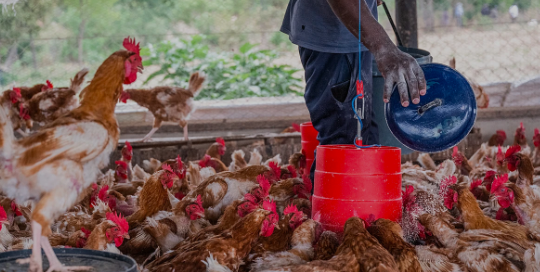
In the vast landscapes of Africa, the relationship between farmers and animals goes beyond a mere economic transaction – it is a deeply intertwined partnership that shapes livelihoods, cultures, and ecosystems. This symbiotic connection is rooted in tradition, necessity, and a profound understanding of the land. This exploration aims to unravel the multifaceted nature of farmer-animal jobs in Africa, shedding light on the integral role animals play in agricultural practices, the livelihoods of farmers, and the preservation of cultural heritage.
The Diversity of Farmer-Animal Partnerships:
A. Smallholder Farming: The majority of farmers in Africa operate on a smallholder scale, often integrating crops and livestock in a harmonious manner. This integration is not only pragmatic but also reflects a deep understanding of the complementary roles animals and crops play in sustainable agriculture.
B. Pastoralism: Across vast savannas and arid landscapes, pastoralists engage in nomadic herding practices. Cattle, goats, sheep, and camels are not just assets; they are companions on a journey where both animals and herders adapt to the rhythm of nature. This mobile lifestyle is a testament to the resilience of the pastoralist-farmer-animal relationship.
C. Agroforestry: In regions where forests and agriculture coexist, farmer-animal partnerships extend to agroforestry systems. Here, animals contribute to the maintenance of agroecological balance by grazing, preventing weed growth, and enhancing soil fertility through manure.
The Economic Significance of Farmer-Animal Jobs:
A. Draught Power in Agriculture: Across Africa, animals play a crucial role in providing draught power for agricultural activities. From plowing fields to transporting goods, animals like oxen are invaluable partners, reducing the physical burden on farmers and enhancing productivity.
B. Livestock Production: Livestock, including cattle, sheep, goats, and poultry, are sources of income, nutrition, and cultural value. The sale of livestock and their products contributes significantly to the economic well-being of farmers, particularly in regions where alternative income sources may be limited.
C. Diversification of Income Streams: Farmer-animal partnerships enable the diversification of income streams. Beyond the direct sale of animals, farmers can derive income from various avenues, including the sale of milk, wool, leather, and other by-products.
D. Fertilization and Soil Health: Animals, through their manure, contribute to soil health and fertility. This natural fertilizer reduces the dependency on chemical inputs, enhancing the sustainability of agricultural practices and promoting healthier soils for crop cultivation.
Cultural Significance and Traditions:
A. Rituals and Ceremonies: Animals are deeply ingrained in the cultural fabric of African societies. Rituals and ceremonies often involve the sacrifice or gifting of animals, symbolizing prosperity, unity, and shared identity within communities.
B. Symbolism and Spirituality: Animals hold symbolic significance in many African cultures, often representing strength, resilience, and spirituality. Certain animals may be considered sacred, and their presence in cultural ceremonies is believed to invoke blessings and protection.
C. Rites of Passage: The journey from adolescence to adulthood is marked by rites of passage, often involving the responsibility of caring for animals. This practice instills values of empathy, stewardship, and interconnectedness with nature.
D. Heritage and Identity: Farmer-animal partnerships are integral to the identity of many African communities. Nomadic herding practices, in particular, are not just economic activities but a way of life that reflects a deep connection to ancestral traditions and the land.
IV. Challenges Faced by Farmer-Animal Partnerships in Africa:
A. Climate Change and Environmental Degradation: Climate change poses a significant threat to both farmers and animals in Africa. Erratic weather patterns, prolonged droughts, and the degradation of grazing lands impact the availability of resources, challenging the resilience of farmer-animal partnerships.
B. Disease Outbreaks: Livestock diseases can have devastating effects on both animal health and the livelihoods of farmers. Outbreaks such as foot-and-mouth disease, brucellosis, and East Coast fever can lead to significant economic losses.
C. Land Use Conflicts: The expansion of agriculture, urbanization, and competing land uses have led to conflicts between farmers, pastoralists, and wildlife. Balancing the needs of different land users is a complex challenge that requires collaborative and sustainable approaches.
D. Limited Access to Veterinary Services: In many remote areas, farmers face challenges in accessing veterinary services. Limited infrastructure, resources, and outreach programs contribute to gaps in disease prevention, control, and treatment.
Opportunities for Sustainable Farmer-Animal Partnerships:
A. Agroecological Practices: Promoting agroecological practices that prioritize the integration of crops and animals can enhance sustainability. Agroecology emphasizes the importance of biodiversity, natural resource management, and ecological balance in farming systems.
B. Improved Breeding Practices: Introducing improved breeding practices can enhance the productivity and resilience of livestock. Breeding for traits such as disease resistance, drought tolerance, and increased reproductive efficiency can contribute to sustainable farmer-animal partnerships.
C. Community-Based Conservation Initiatives: Engaging local communities in conservation efforts can be effective. Community-based initiatives that promote sustainable grazing practices, watershed management, and the protection of natural habitats contribute to the well-being of both farmers and animals.
D. Technology Adoption: The adoption of technology, such as mobile veterinary clinics, digital platforms for market access, and climate-smart agriculture practices, can bridge gaps in service delivery, improve livestock management, and enhance the overall sustainability of farmer-animal partnerships.
VI. The Future of Farmer-Animal Partnerships in Africa:
A. Climate-Resilient Agriculture: Farmer-animal partnerships must adapt to the challenges posed by climate change. This may involve the development of climate-resilient livestock breeds, the implementation of sustainable land management practices, and the incorporation of climate-smart agricultural techniques.
B. Integration of Traditional Knowledge and Innovation: Balancing traditional knowledge with innovative solutions is key to the future of farmer-animal partnerships. Integrating indigenous wisdom with modern technologies can enhance the adaptive capacity of farmers and contribute to sustainable agricultural practices.
C. Education and Capacity Building: Enhancing the knowledge and skills of farmers through education and capacity-building programs is essential. Training in sustainable farming practices, animal husbandry, and climate-resilient agriculture empowers farmers to navigate the challenges of a changing environment.
D. Policy Support: Governments and policymakers play a critical role in supporting sustainable farmer-animal partnerships. Policies that prioritize agroecological practices, provide access to veterinary services, and address land use conflicts contribute to a conducive environment for thriving partnerships.
Conclusion
In conclusion, farmer-animal partnerships in Africa represent a dynamic and interconnected web of relationships that extend beyond the boundaries of economic transactions. These partnerships are embedded in the cultural, social, and ecological fabric of the continent. As Africa navigates the complexities of climate change, economic development, and cultural transformation, the role of animals in agriculture becomes increasingly crucial.
The sustainability of farmer-animal partnerships hinges on a delicate balance between tradition and innovation, resilience and adaptation. By recognizing the value of indigenous knowledge, embracing technological advancements, and fostering community-led conservation efforts, Africa can build a future where farmer-animal partnerships thrive, contributing to food security, cultural heritage preservation, and environmental sustainability. The journey towards a harmonious coexistence between farmers and animals in Africa is not just a practical necessity; it is a profound reflection of the shared journey of communities with the land and its inhabitants.







